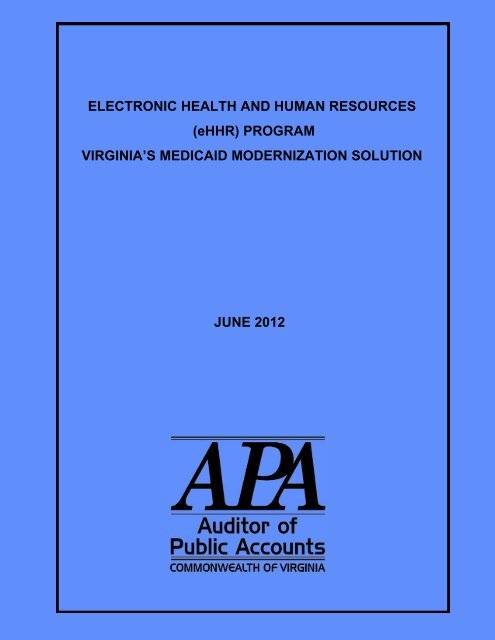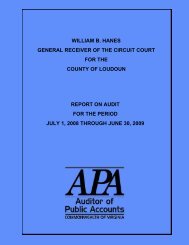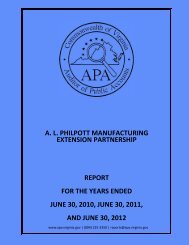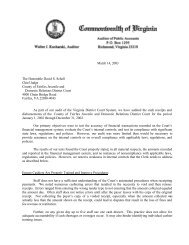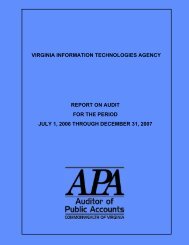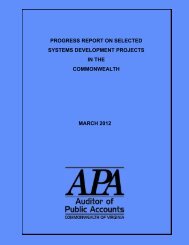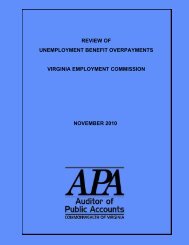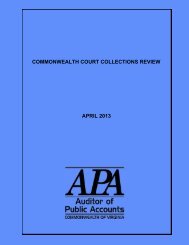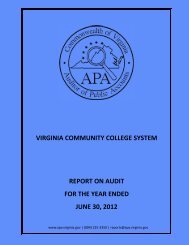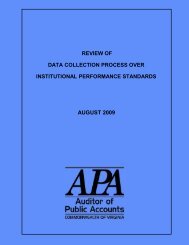Electronic Health and Human Resources (eHHR) - Virginia Auditor ...
Electronic Health and Human Resources (eHHR) - Virginia Auditor ...
Electronic Health and Human Resources (eHHR) - Virginia Auditor ...
You also want an ePaper? Increase the reach of your titles
YUMPU automatically turns print PDFs into web optimized ePapers that Google loves.
ELECTRONIC HEALTH AND HUMAN RESOURCES<br />
(<strong>eHHR</strong>) PROGRAM<br />
VIRGINIA’S MEDICAID MODERNIZATION SOLUTION<br />
JUNE 2012
Executive Summary<br />
This first report reflects our on-going review of the <strong>eHHR</strong> Program Management Office <strong>and</strong><br />
the information technology projects it is overseeing, which is a $101 million joint investment<br />
between <strong>Virginia</strong> <strong>and</strong> the federal government. These projects <strong>and</strong> the management of the <strong>eHHR</strong><br />
Program Management Office represent the development of the information technology infrastructure<br />
that will improve <strong>Virginia</strong>’s ability to administer effective social services, support Medicaid<br />
expansion, a <strong>Health</strong> Benefits Exchange, <strong>and</strong> compliance with other aspects of the Patient Protection<br />
<strong>and</strong> Affordable Care Act of 2010.<br />
There are numerous risks that could adversely affect the success of the <strong>eHHR</strong> Program.<br />
Some of these risks are outside the control of the Program Director <strong>and</strong> some are risks common to<br />
information systems development projects:<br />
<br />
<br />
<br />
<br />
<br />
<br />
Program Management Offices are New in <strong>Virginia</strong> – This is the first time the<br />
Commonwealth has used a Program Management Office to oversee multiple projects, <strong>and</strong><br />
current project management st<strong>and</strong>ards may not always be suitable.<br />
Program Authority – The <strong>Virginia</strong> Secretary of <strong>Health</strong> <strong>and</strong> <strong>Human</strong> <strong>Resources</strong> <strong>and</strong> the<br />
Commonwealth Chief Information Officer need to clearly document in the <strong>eHHR</strong><br />
Program Charter the organizational <strong>and</strong> reporting structure of the <strong>eHHR</strong> Program Office.<br />
Condensed Timeline – Ideally, the <strong>eHHR</strong> Program Office would have been established,<br />
followed by planning its projects <strong>and</strong> their interdependencies. In reality, <strong>Virginia</strong> had to<br />
begin early to prepare for Medicaid expansion by October 2013 <strong>and</strong> started several<br />
projects before the <strong>eHHR</strong> Program was staffed <strong>and</strong> operating. Also, the Department of<br />
Social Services has less than two years to secure a vendor to replace its current Medicaid<br />
eligibility system. The <strong>eHHR</strong> Program Office has established program milestones, but<br />
does not have a critical path based on detailed project plans <strong>and</strong> interdependencies.<br />
<strong>Health</strong>care Reform Uncertainty – The Supreme Court ruling on the Patient Protection<br />
<strong>and</strong> Affordable Care Act of 2010 will not occur until June 2012.<br />
Uncertain Timeline Flexibility – Due to the complicated uncertainty of <strong>Health</strong>care<br />
Reform <strong>and</strong> state responsibilities for conforming, key stakeholders believe that the<br />
October 2013 deadline will have to be pushed back. However, if the Patient Protection<br />
<strong>and</strong> Affordable Care Act of 2010 is upheld, it would take an act of Congress to amend the<br />
law to extend the Medicaid expansion deadlines.<br />
Restrictions on Data Sharing Among Agencies - Federal <strong>and</strong> state laws restrict agencies<br />
from readily sharing recipient information. The legislature did not approve proposed<br />
budget language to remove state data sharing barriers. As an interim solution, the <strong>eHHR</strong><br />
Program Office is working with the Attorney General’s Office to develop a data sharing<br />
agreement <strong>and</strong> legislation that would permit agencies to share information. Delays in<br />
finalizing this agreement could adversely affect the <strong>eHHR</strong> program.<br />
Our review hopes to detect problems at the earliest possible point <strong>and</strong> inform <strong>and</strong> alert<br />
decision makers so that they can take action to reduce potential failures. In this report, we highlight<br />
the progress of the <strong>eHHR</strong> Program Office as well as selected projects we are actively monitoring.<br />
We identify risks <strong>and</strong> make recommendations where applicable to improve both program <strong>and</strong> project<br />
management practices.
- T A B L E O F C O N T E N T S -<br />
EXECUTIVE SUMMARY<br />
Pages<br />
ELECTRONIC HEALTH AND HUMAN RESOURCES (<strong>eHHR</strong>) PROGRAM 1-9<br />
SERVICE-ORIENTED ARCHITECTURE/ENTERPRISE DATA MANAGEMENT 10-15<br />
COMMONWEALTH AUTHENTICATION SERVICE 15-17<br />
INDEPENDENT AUDITOR’S LETTER 18<br />
AGENCY RESPONSE 19-20<br />
AGENCY OFFICIALS 21<br />
APPENDIX 22-24
Background<br />
electronic <strong>Health</strong> <strong>and</strong> <strong>Human</strong> <strong>Resources</strong> (<strong>eHHR</strong>) Program<br />
In April 2011, the <strong>Auditor</strong> of Public Accounts planned to begin an ongoing review of the<br />
Department of Social Services’ replacement of its Medicaid-eligibility determination system.<br />
However, the impending Medicaid expansion triggered by the Patient Protection <strong>and</strong> Affordable<br />
Care Act of 2010 (the Act) prompted the Commonwealth to reassess its entire health information<br />
technology infrastructure. After taking on several forms, the Commonwealth’s overall vision of<br />
“providing access to the right services for the right people at the right time <strong>and</strong> for the right cost”<br />
resulted in the electronic <strong>Health</strong> <strong>and</strong> <strong>Human</strong> <strong>Resources</strong> (<strong>eHHR</strong>) Program.<br />
Consequently, we revised the scope of our review to monitor the ongoing efforts of the<br />
<strong>eHHR</strong> Program. The purpose of this report is to provide readers with a brief history of the Program,<br />
the work of the Program to date, <strong>and</strong> note risks the Program must manage to keep successfully<br />
moving forward.<br />
History<br />
The Commonwealth has recognized the need to modernize its Medicaid-eligibility system<br />
since 2005. However, the cost of the modernization effort would have placed too great of a financial<br />
burden on both state <strong>and</strong> local government resources. Historically, the federal government<br />
reimbursed <strong>Virginia</strong> for 50 percent of its Medicaid expenses <strong>and</strong> most likely would have only<br />
reimbursed <strong>Virginia</strong> for 50 percent of the expenses of any modernization efforts.<br />
In 2010 the Centers for Medicare <strong>and</strong> Medicaid Services increased federal reimbursement<br />
percentages for certain projects up to 90 percent. Recognizing the increased funding opportunities,<br />
<strong>and</strong> the overall inefficiencies that existed within the <strong>Health</strong> <strong>and</strong> <strong>Human</strong> <strong>Resources</strong> Secretariat, Dr.<br />
William Hazel, the <strong>Virginia</strong> Secretary of <strong>Health</strong> <strong>and</strong> <strong>Human</strong> <strong>Resources</strong>, engaged other stakeholders<br />
within the Commonwealth to improve the quality <strong>and</strong> value of <strong>Virginia</strong> healthcare by modernizing<br />
information systems.<br />
In 2010, the U.S. Congress passed the Patient Protection <strong>and</strong> Affordable Care Act (the Act).<br />
The primary components of the Act that will affect state governments are Medicaid expansion <strong>and</strong><br />
the creation of a <strong>Health</strong> Benefit Exchange, an online marketplace where individuals <strong>and</strong> small<br />
businesses can compare <strong>and</strong> purchase healthcare insurance policies. These m<strong>and</strong>ates take effect<br />
October 2013 <strong>and</strong> January 2014, respectively.<br />
The <strong>Virginia</strong> Secretary of <strong>Health</strong> <strong>and</strong> <strong>Human</strong> <strong>Resources</strong> predicts the Act will increase the<br />
number of Medicaid-eligible <strong>Virginia</strong>ns between 35 <strong>and</strong> 45 percent <strong>and</strong> the Commonwealth does not<br />
currently have the administrative capacity to manage this increase effectively. As to the <strong>Health</strong><br />
Benefit Exchange requirement, states have flexibility in the type <strong>and</strong> breadth of the exchange they<br />
offer. However, if <strong>Virginia</strong> fails to establish a <strong>Health</strong> Benefit Exchange by January 2014, it forfeits<br />
this flexibility <strong>and</strong> the federal government will dictate the terms of the Commonwealth’s exchange.<br />
1
Prior to the Act, the Department of Medical Assistance Services, which manages the<br />
Medicaid program, was already participating in the Medicaid Information Technology Architecture<br />
(MITA). MITA is a joint initiative of the Centers for Medicare <strong>and</strong> Medicaid Services <strong>and</strong> the<br />
Center for Medicaid <strong>and</strong> State Operations to st<strong>and</strong>ardize business processes, st<strong>and</strong>ards, <strong>and</strong><br />
technology maturity to help prepare states for the expansion of the Medicaid program.<br />
All states must comply with the MITA st<strong>and</strong>ards when they change their Medicaid<br />
information technology systems. These st<strong>and</strong>ards apply to three areas; business architecture,<br />
information architecture, <strong>and</strong> technical architecture. By complying with MITA guidelines, states<br />
will create a common information technology system that will provide access to data by state <strong>and</strong><br />
other medical agencies.<br />
In order to comply with MITA st<strong>and</strong>ards, the Commonwealth began three projects before the<br />
<strong>eHHR</strong> Program Office was staffed <strong>and</strong> operational. The following chart lists the three projects <strong>and</strong><br />
describes their objectives.<br />
Chart 1<br />
Projects Begun to Comply with MITA<br />
Project<br />
Description<br />
Service-Oriented Architecture<br />
Environment (SOAE)<br />
A suite of several tools will expedite connecting legacy<br />
applications to new services, support sharing <strong>and</strong> reuse of<br />
Web services across agencies, facilitate the automation of<br />
business rules, <strong>and</strong> much more.<br />
Enterprise Data Management<br />
(EDM)<br />
Is “Emmitt Smith” the same person as “E. M. Smyth”<br />
EDM’s sophisticated logic will bring together data from<br />
multiple sources to provide a single, “trusted” view of<br />
data entities.<br />
Commonwealth Authentication<br />
Service (CAS)<br />
Offered by the Department of Motor Vehicles (DMV) in<br />
collaboration with the <strong>Virginia</strong> Information Technologies<br />
Agency (VITA), CAS will provide improved verification<br />
of identity, expediting citizens’ access to services while<br />
protecting against identity theft <strong>and</strong> fraudulent activities.<br />
In addition to these projects, the Department of Social Services, under Dr. Hazel’s direction,<br />
had begun exploring the replacement of its Medicaid eligibility system, ADAPT. As the number,<br />
scope, <strong>and</strong> size of projects needed to prepare <strong>Virginia</strong> for <strong>Health</strong>care Reform increased, Dr. Hazel<br />
advocated for the creation of the <strong>eHHR</strong> Program. The <strong>eHHR</strong> Program consists of a program office<br />
that is responsible for coordinating all of the individual projects needed to support the Act <strong>and</strong><br />
MITA.<br />
2
Program Risk #1 – Operationalizing Program Office After Beginning Projects<br />
System development best practices call for the <strong>eHHR</strong> Program Office to complete initiation<br />
<strong>and</strong> planning before starting projects. Doing initiation <strong>and</strong> planning allows the program office to<br />
establish structure <strong>and</strong> develop tools to control <strong>and</strong> monitor individual projects. However, as a<br />
result of initiatives already undertaken to support MITA, the three projects noted above were started<br />
before the <strong>eHHR</strong> Program Office was staffed <strong>and</strong> operational.<br />
Although this is not best practice, the Program Office now finds itself in the challenging<br />
position of planning for three projects that are already approaching their execution phase while<br />
simultaneously planning for its remaining projects. This situation has created uncertainty amongst<br />
the current three project teams as to whether they should wait to use Program Office tools <strong>and</strong><br />
templates; or continue developing their own, as discussed later in Program Risk #8.<br />
This situation has also resulted in the Program Office developing a schedule, budget, <strong>and</strong> key<br />
milestones without actual detailed project schedules, as discussed later in Program Risk # 5. We<br />
will continue to monitor the Program Office as it works to create the structure needed to effectively<br />
monitor all projects <strong>and</strong> their impact on meeting the m<strong>and</strong>ated deadlines.<br />
Purpose of <strong>eHHR</strong> Program<br />
The <strong>eHHR</strong> Program Office will manage <strong>and</strong> promote <strong>eHHR</strong> projects in coordination with<br />
federal <strong>and</strong> state direction to improve healthcare <strong>and</strong> human services. The <strong>eHHR</strong> Program seeks to<br />
build on current healthcare reform efforts, modernize the Commonwealth’s information technology<br />
infrastructure, ensure operability between new <strong>and</strong> legacy information systems, <strong>and</strong> reduce the<br />
overall long-term technology costs of managing the Medicaid program by providing a web-based,<br />
self-directed option for health services <strong>and</strong> reducing the need for large administrative <strong>and</strong><br />
operational staff.<br />
Furthermore, the <strong>eHHR</strong> Program cited the following six goals in its Charter.<br />
1) Leverage the Medicaid Information Technology Architecture (MITA) to align <strong>Virginia</strong>’s<br />
efforts with Federal direction <strong>and</strong> thereby enable maximum Federal funding participation.<br />
2) Fulfill Federal requirements for <strong>Health</strong> Information Exchange (HIE) <strong>and</strong> Meaningful Use<br />
under the ARRA.<br />
3) Fulfill Federal requirements for Medicaid expansion <strong>and</strong> the <strong>Health</strong> Insurance/Benefit<br />
Exchange (HBE) under <strong>Health</strong>care Reform to minimize long-term fixed cost increases.<br />
4) Communicate the progress, status, issues, <strong>and</strong> risks for a complex program to stakeholder<br />
groups in an underst<strong>and</strong>able manner.<br />
5) Provide a program management infrastructure that each chartered project can leverage to<br />
eliminate duplicative efforts <strong>and</strong> reduce project management overhead.<br />
6) Provide change management assistance, coordination, <strong>and</strong> support to impacted<br />
organizations as part of business process reengineering efforts.<br />
3
In its current state, the Patient Protection <strong>and</strong> Affordable Care Act (Act) exp<strong>and</strong>s Medicaid<br />
eligibility requirements in October 2013 <strong>and</strong> requires states to have a working <strong>Health</strong> Benefit<br />
Exchange by January 2014. The <strong>eHHR</strong> Program’s goals reflect these provisions of the Act. Key<br />
stakeholders believe the replacement of the Commonwealth’s architectures <strong>and</strong> eligibility systems<br />
will reduce fraud <strong>and</strong> abuse, better detect remaining fraud <strong>and</strong> abuse, increase operational<br />
efficiencies, reduce operational costs, improve enrollment accuracy, <strong>and</strong> improve government<br />
services to citizens.<br />
Program Risk #2 – <strong>Health</strong>care Reform Uncertainty <strong>and</strong> Timeline Flexibility<br />
The Supreme Court of the United States heard challenges to the Patient Protection <strong>and</strong><br />
Affordable Care Act of 2010, specifically the Individual M<strong>and</strong>ate that requires every American to<br />
purchase insurance, Medicaid Expansion, <strong>and</strong> the Severability of the Act. The Supreme Court<br />
should rule sometime in June 2012 on each of these issues. The outcome of this case is uncertain<br />
<strong>and</strong> this uncertainty could affect buy-in from stakeholders.<br />
Regardless of the Supreme Court ruling, it is unlikely there will be an effect on the funding of<br />
the previously discussed projects. In addition, the federal government will still reimburse 90 percent<br />
of the costs to modernize the Medicaid Eligibility system. However, funding is not the only concern<br />
for the <strong>eHHR</strong> Program Office; the Commonwealth may still need to prepare for Medicaid expansion<br />
by October 2013.<br />
Key stakeholders in the <strong>eHHR</strong> Program believe that Congress, the Supreme Court or<br />
administrative actions could delay the Medicaid expansion deadline of October 2013. If there is no<br />
deadline delay, <strong>Virginia</strong> must be ready to enroll as many as 350,000 newly eligible citizens. In<br />
order to h<strong>and</strong>le the increased population, <strong>Virginia</strong> has to either have these <strong>eHHR</strong> projects<br />
completed, or have a contingency plan to deal with increased caseloads at local Departments of<br />
Social Services.<br />
Scope of the <strong>eHHR</strong> Program<br />
The <strong>eHHR</strong> Program Office will oversee between 13 <strong>and</strong> 16 individual projects that will<br />
implement information technology systems, business processes, <strong>and</strong> organizational changes. The<br />
modernization efforts will ensure that <strong>Virginia</strong> improve its administrative effectiveness <strong>and</strong> reduce<br />
errors in social service programs.<br />
4
<strong>eHHR</strong> Program Projects<br />
Chart 2<br />
The <strong>eHHR</strong> Program will require support from agencies within the <strong>Health</strong> <strong>and</strong> <strong>Human</strong><br />
<strong>Resources</strong> Secretariat, as well as the <strong>Virginia</strong> Information Technologies Agency (VITA), the<br />
Department of Motor Vehicles (DMV), <strong>and</strong> the Department of General Services’ Division of<br />
Consolidated Laboratory Services. The <strong>eHHR</strong> Program’s success also relies on continued <strong>and</strong><br />
appropriate funding <strong>and</strong> personnel resources, continued support from Commonwealth leadership, the<br />
continued partnership of both VITA <strong>and</strong> Northrup Grumman, <strong>and</strong> most importantly, an enterprise<br />
trust agreement across all Commonwealth secretariats <strong>and</strong> agencies so they can share data. Data<br />
sharing is discussed later in Program Risk #6.<br />
The <strong>eHHR</strong> Program Charter notes that the Secretary of <strong>Health</strong> <strong>and</strong> <strong>Human</strong> <strong>Resources</strong> is the<br />
program sponsor, <strong>and</strong> in that role will provide leadership, keep the <strong>eHHR</strong> Program aligned with the<br />
Commonwealth’s strategy, govern program risk, <strong>and</strong> ensure continuity of sponsorship. Dr. Hazel<br />
currently provides strong leadership for this program; however, the <strong>eHHR</strong> Program will most likely<br />
exist past Dr. Hazel’s term as Secretary of <strong>Health</strong> <strong>and</strong> <strong>Human</strong> <strong>Resources</strong>.<br />
To ensure that future leaders continue to champion the importance of the <strong>eHHR</strong> Program, the<br />
Secretary of <strong>Health</strong> <strong>and</strong> <strong>Human</strong> Services is actively working now to align all agency heads to the<br />
strategic goals included in his Information Technology Strategic Plan.<br />
5
Because Medicaid is funding the projects under the <strong>eHHR</strong> Program, Dr. Hazel named David<br />
Mix, a Department of Medical Assistance Services’ employee, as the Program Management Office<br />
Director, a position similar to an agency head. Even though funding is through Medical Assistance<br />
Services, the <strong>eHHR</strong> Program Management Director reports to Secretary Hazel. The <strong>eHHR</strong> Program<br />
Office is funding all of the projects; <strong>and</strong> therefore views the other agencies, such as VITA <strong>and</strong><br />
DMV, as both team members <strong>and</strong> service providers <strong>and</strong> itself as team member <strong>and</strong> “paying<br />
customer.” As a result, other agencies must adhere to their direction. The following chart illustrates<br />
the organizational structure developed by the <strong>eHHR</strong> Program Office to achieve its objectives.<br />
<strong>eHHR</strong> Organizational Chart<br />
Chart 3<br />
<strong>eHHR</strong> Program<br />
Org. Change Mgr. &<br />
SHHR IT Advisor:<br />
M. Wirth<br />
<strong>eHHR</strong> Program Oversight<br />
Committee (POC) Chair: Sec. Hazel<br />
<strong>eHHR</strong> Program Director: D. Mix<br />
<strong>eHHR</strong> Program Manager: L. Reed<br />
DSS<br />
Program Manager: TBD<br />
Projects:<br />
Eligibility System<br />
Replacement<br />
/VaCMS:<br />
TBD<br />
External Rules<br />
Engine<br />
Development:<br />
TBD<br />
Document<br />
Management<br />
Imaging System<br />
(DMIS):<br />
TBD<br />
Customer Portal<br />
Enhancements<br />
Kevin Platea<br />
Prasanna<br />
Pasyavala<br />
Birth Report<br />
Intrfx (BRI)<br />
TBD<br />
Death Report<br />
Intrfx (DRI)<br />
TBD<br />
Elec. Lab<br />
Reporting Intrfx<br />
(ELRI)<br />
TBD<br />
Syndromic<br />
Surveillance<br />
Intrfx (SSI)<br />
TBD<br />
<strong>eHHR</strong><br />
Projects:<br />
Rhapsody<br />
Connectivity<br />
(RC)<br />
TBD<br />
Immunization<br />
Report Intrfx<br />
(IRI)<br />
TBD<br />
DMAS Eligibility<br />
Sys. Support<br />
(DESS)<br />
Carrie<br />
McDermott<br />
<strong>Health</strong> Benefits<br />
Exchange (HBE)<br />
TBD<br />
DMV<br />
Commonwealth<br />
Authentication<br />
Service (CAS)<br />
Mike Farnsworth<br />
VITA/MITA<br />
Program Manager:<br />
Lynne Jeffries<br />
Projects:<br />
Enterprise Data<br />
Mgt. (EDM)<br />
Sean Weir<br />
Svc. Oriented<br />
Architecture<br />
(SOA)<br />
Kelly Edwards<br />
Shared Support: Commonwealth Data Group (CDG); VITA Enterprise Arch.; <strong>eHHR</strong> SOA Solution Architect; VITA PMD<br />
6
Program Risk #3 – <strong>eHHR</strong> Program Management Office Organizational Structure<br />
We observed tension in the relationship between VITA <strong>and</strong> the <strong>eHHR</strong> Program Office. This<br />
tension is likely the result of confusion that may exist over the authority <strong>and</strong> control of the SOAE <strong>and</strong><br />
EDM projects. As discussed earlier in this report, these projects were started by VITA before the<br />
<strong>eHHR</strong> Program Office was operational <strong>and</strong> the organizational structure noted in Chart 3 existed.<br />
Without an <strong>eHHR</strong> Program Office, the SOAE <strong>and</strong> EDM project charters created a reporting<br />
structure that involved a SOAE/EDM program manager as well as the Chief Information Officer,<br />
<strong>and</strong> that structure does not conform to the <strong>eHHR</strong> organizational chart shown above.<br />
Now that the <strong>eHHR</strong> Program Office is operational, the Secretary of <strong>Health</strong> <strong>and</strong> <strong>Human</strong><br />
<strong>Resources</strong> needs to determine the proper role within the organizational structure for the Chief<br />
Information Officer <strong>and</strong> document that role within the <strong>eHHR</strong> Program charter <strong>and</strong> the<br />
organizational structure shown above. In addition, if necessary, the SOAE/EDM project charters<br />
should be revised to conform to the <strong>eHHR</strong> organizational structure.<br />
Projects <strong>and</strong> Budgets<br />
According to updated project estimates provided in May, the combined cost of the <strong>eHHR</strong><br />
Program Office <strong>and</strong> its projects is about $101 million. Individual projects are discussed in further<br />
detail in the appendix to this report. Of the $101 million, management estimates a cost of about $4.8<br />
million to support the <strong>eHHR</strong> Program Management Office.<br />
The individual project budgets in the <strong>eHHR</strong> Program Charter use early estimates <strong>and</strong><br />
continue to evolve. Between May 1 <strong>and</strong> June 15, 2011, estimates for the total projected investment<br />
have ranged from $170 million, down to $124 million, <strong>and</strong> now down to $101 million. The <strong>eHHR</strong><br />
Program Office recently submitted <strong>and</strong> received approval for its second budget change request from<br />
the federal Centers for Medicare <strong>and</strong> Medicaid Services (CMS). The first budget request was for a<br />
four-year period while the second round of funding was limited to federal fiscal years 2012 <strong>and</strong><br />
2013. We will examine the <strong>eHHR</strong> Program’s budget in more detail in a future report when the<br />
<strong>eHHR</strong> Program Office can provide a more detailed budget for the <strong>eHHR</strong> Program <strong>and</strong> its projects<br />
over the full life cycle of the <strong>eHHR</strong> Program Office.<br />
The <strong>eHHR</strong> Program Office estimates it will cost $51 million, or about 51 percent of the<br />
<strong>eHHR</strong> Program’s baseline cost, to replace the Medicaid eligibility system at the Department of<br />
Social Services. The Department of Social Services submitted a Request for Proposals (RFP) to<br />
CMS in April 2012 <strong>and</strong> received approval on approval May 23, 2012. The Department of Social<br />
Services posted the RFP to the Commonwealth’s electronic procurement system on May 25, 2012<br />
<strong>and</strong> is relying on having a vendor in place by October 2012. They are requiring the vendor to<br />
complete replacement of the system by July 2013. According to VITA, projects of similar scope <strong>and</strong><br />
size typically take nine months from the issuance of the RFP to having a signed contract with a<br />
vendor; but, the <strong>eHHR</strong> Program Office is hoping to accomplish this within four months.<br />
7
Program Risk #4 - Eligibility System Replacement Deadline<br />
The Medicaid eligibility system replacement project is both the largest financial investment<br />
of the <strong>eHHR</strong> Program <strong>and</strong> one of the most critical for the Commonwealth to deal with the Medicaid<br />
expansion in October 2013. In order to go live with the new system by the Medicaid expansion<br />
target of October 2013, the new system must have CMS’ approval <strong>and</strong> certification in July 2013, or<br />
about nine months after DSS hopes to have a signed contract with the vendor.<br />
The shortened window to secure a vendor <strong>and</strong> replace the eligibility system is a risk to the<br />
<strong>eHHR</strong> Program Office. To minimize the risk that the Commonwealth will not have the system<br />
components necessary to meet Medicaid expansion, the <strong>eHHR</strong> Program has begun planning for that<br />
contingency. Contingency plans may include securing funding for <strong>and</strong> training additional eligibility<br />
workers on a part-time basis until the new system goes live. The <strong>eHHR</strong> Program should continue to<br />
develop their contingency plan to ensure the Commonwealth is prepared for Medicaid expansion<br />
even if the new eligibility system is not completed.<br />
Included in the $51 million estimate to replace the Medicaid eligibility system are several<br />
other projects. These projects include enhancing the Department of Social Services current webbased<br />
customer portal, defining rules for an eligibility rules engine, <strong>and</strong> ensuring that the system<br />
interfaces with the statewide Enterprise Service Bus <strong>and</strong> additional SOA tools <strong>and</strong> components<br />
under development within the SOAE program, as discussed in a later section of this report.<br />
The Service-Oriented Architecture Environment, or SOAE, has an estimated cost of about<br />
$16.8 million. It is the second largest individual project by cost, <strong>and</strong> just as critical as the<br />
replacement of the Medicaid eligibility system to the overall success of the <strong>eHHR</strong> Program. The<br />
Service-Oriented Architecture will expedite connecting legacy applications to new services, support<br />
the sharing <strong>and</strong> reuse of web services across agencies, <strong>and</strong> facilitate the automation of business rules.<br />
As noted earlier in this report, SOAE is one of the three projects that began prior to the<br />
operationalization of the <strong>eHHR</strong> Program Office. The Enterprise Data Management (EDM) project is<br />
a sister project to the SOAE <strong>and</strong> has a total estimated cost of about $7.6 million. The third project<br />
underway is the Commonwealth Authentication Service, or CAS, with a total estimated cost of $4.4<br />
million. These three projects, combined with the replacement of the Medicaid eligibility system,<br />
account for about 79 percent of the estimated cost of the projects under the <strong>eHHR</strong> Program Office.<br />
8
Program Risk #5 – No Critical Path to Support the Feasibility of Meeting Deadline<br />
The Medicaid eligibility system, SOAE, EDM <strong>and</strong> CAS, as well as subsequent projects, are<br />
interrelated <strong>and</strong> have interdependencies. In simplified terms, the CAS project may not be able to<br />
complete task C until the EDM project completes task B which is impossible until the SOAE project<br />
completes task A.<br />
The <strong>eHHR</strong> Program Manager has documented key milestone dates related to the project.<br />
However, the <strong>eHHR</strong> Program has yet to document the detailed interdependencies <strong>and</strong> critical path<br />
for the projects based on detailed project schedules. Without a critical path based on these detailed<br />
project schedules, the <strong>eHHR</strong> Program Office cannot guarantee that it will meet the key deadlines<br />
already discussed in this report. The <strong>eHHR</strong> Program Office <strong>and</strong> the various projects it oversees<br />
must document their critical path as quickly as possible.<br />
9
Service-Oriented Architecture Environment (SOAE)<br />
<strong>and</strong> Enterprise Data Management (EDM)<br />
VITA is developing the SOAE <strong>and</strong> EDM solutions that serve as the foundation of the <strong>eHHR</strong><br />
Program. The following conceptual diagram is a simple illustration of SOAE <strong>and</strong> EDM.<br />
Chart 4<br />
SOAE <strong>and</strong> EDM Conceptual Diagram<br />
The SOAE products include the Enterprise Service Bus, a Workflow Engine, a Business<br />
Rules Engine, <strong>and</strong> tools that will enable agencies to connect existing legacy systems to the<br />
Enterprise Service Bus. The SOAE products will allow for agency access to various other services,<br />
such as the EDM solution, built on IBM’s Initiate Master Data Service.<br />
The EDM will enable agencies to match records <strong>and</strong> exchange information across data<br />
systems. By using st<strong>and</strong>ard attributes common in many Commonwealth agency systems, it becomes<br />
possible to link records across these systems using probability-based matching algorithms. This<br />
service has the potential to greatly reduce enrollment error rates, improve fraud prevention <strong>and</strong><br />
detection, <strong>and</strong> automate services that can accurately retrieve information.<br />
For example, when Emmitt Smith of 742 Blue Ridge Terrace enters a local Social Services<br />
office <strong>and</strong> applies for Medicaid, the social worker can use EDM to compare related records from<br />
multiple state agencies to ensure that the Emmitt Smith they are working with is the same person<br />
they have information on. For example, DSS may have tax records for an E.M. Smyth of 742 Blue<br />
Ridge Terrace that shows he does not meet the income threshold to qualify for Medicaid.<br />
10
Historically, tools needed for sophisticated data matching have been too expensive for<br />
agencies to procure individually. The Patient Protection <strong>and</strong> Affordability Act authorized CMS to<br />
fund at least 90 percent of a state’s effort to build the required infrastructure that would support<br />
Medicaid expansion <strong>and</strong> the health benefits exchange.<br />
At the direction of the Secretary <strong>and</strong> <strong>eHHR</strong> Program Director, VITA moved forward with the<br />
SOAE <strong>and</strong> the EDM projects.<br />
Program Risk #6 – Agencies Must Be Allowed to Share Data for EDM to Operate Successfully<br />
In order for EDM to match records <strong>and</strong> exchange information as planned, agencies must<br />
share their data with other authorized entities. Currently, federal <strong>and</strong> state laws restrict agencies<br />
from readily sharing recipient information. In order to expedite EDM <strong>and</strong> eliminate any state<br />
barriers to data sharing, the Governor introduced a budget amendment during the 2012 veto session<br />
to authorize data sharing. This amendment was not approved by the legislature, <strong>and</strong> the Governor<br />
plans to re-introduce this language in 2013. Relative to federal restrictions, federal agencies are<br />
holding meetings to administratively allow the sharing of information; however, there are no draft<br />
regulations available.<br />
In the meantime, the <strong>eHHR</strong> Program Office is working with the Attorney General’s office to<br />
develop a data sharing agreement that <strong>Virginia</strong> agencies can use to negotiate with others about<br />
using recipient information. The <strong>eHHR</strong> Program Office views this agreement as key to data sharing<br />
<strong>and</strong> delays in finalizing it could render EDM ineffective until it is resolved.<br />
Currently, both the SOAE <strong>and</strong> EDM projects are in the detailed planning phase of the project<br />
life cycle. This phase began in September 2011 <strong>and</strong> VITA estimates that detailed planning will<br />
conclude by the end of June 2012.<br />
Best practices recommend developing a project plan early in the project planning phase <strong>and</strong><br />
managing the project according to the plan. As a result, it is essential to the success of the projects<br />
that the project plans include sufficient detail to manage the overall project plan to completion. We<br />
reviewed the draft plans for both projects, <strong>and</strong> recommend the Project Manager ensure the final<br />
plans incorporate the following best practices.<br />
<br />
<br />
<br />
Identify <strong>and</strong> assign specific resources to individual tasks within the project plan. Project<br />
management best practice suggests that each task within the project schedule have at least<br />
one team member <strong>and</strong> clearly define project roles <strong>and</strong> responsibilities, preferably with no<br />
overlap of accountabilities.<br />
Include duration, actual hours worked, <strong>and</strong> remaining work for each task in the project<br />
plan. Tracking these will indicate the most accurate project status to all key stakeholders.<br />
Project management best practices recommend that tasks be broken down in the lowest<br />
possible level of work; generally, no task should take longer than 80 hours to complete.<br />
This level of detail allows the project manager to monitor <strong>and</strong> control each task; <strong>and</strong><br />
make adjustments to their schedule <strong>and</strong> plan when tasks are late. Further, it gives the<br />
assigned team member a clearer underst<strong>and</strong>ing of what they need to do to accomplish the<br />
task.<br />
11
The project plan should identify the tasks that create the critical path. The critical path is<br />
the series of tasks <strong>and</strong> deadlines that team members must complete for a project to finish<br />
on schedule. If a single task is late on the critical path, the end date of the entire project<br />
may also be late.<br />
Program Risk #7 – Project Documents Must Meet Best Practices to Receive VITA PMD<br />
Approval<br />
Commonwealth Project Management St<strong>and</strong>ards require approval by the VITA Project<br />
Management Division (PMD) of the detailed project plan prior to proceeding with project execution.<br />
We recommend that the SOAE <strong>and</strong> EDM project managers continue to work closely with PMD to<br />
ensure there are no delays in the execution <strong>and</strong> control phase resulting from prolonged review or<br />
additional iterations of the final project plan. Beginning execution on time is especially important<br />
because the project has the first development environment in the execution phase scheduled for<br />
completion on July 3 rd <strong>and</strong> this environment is critical to the CAS project plan.<br />
The SOAE <strong>and</strong> EDM project managers should also ensure the project plan best practices<br />
described above incorporated prior to project execution. These best practices will help enhance the<br />
project plan <strong>and</strong> allow the project managers to better monitor the projects.<br />
In addition, the detailed baseline project plans, specifically critical tasks, need to be<br />
incorporated into the overall <strong>eHHR</strong> Program Office project plan. The Project <strong>and</strong> <strong>eHHR</strong> Program<br />
Managers must maintain <strong>and</strong> adhere to the project plan in order for it to be an effective tool to<br />
monitor the <strong>eHHR</strong> Program’s progress.<br />
VITA PMD approval is required before a project can move into the execution <strong>and</strong> control<br />
phase. The following chart identifies documents PMD requires before granting their approval, along<br />
with their current status for the SOAE <strong>and</strong> EDM projects.<br />
Required Project Management Documents<br />
Chart 5<br />
Required Documentation SOAE EDM<br />
Work Breakdown Schedule * *<br />
Resource Plan * *<br />
Project Schedule * *<br />
Project Budget X X<br />
Performance Plan X X<br />
Risk Management Plan * *<br />
Procurement Plan @ @<br />
Communications Plan * *<br />
Change <strong>and</strong> Configuration Management Plan * *<br />
X – Complete<br />
* - In Draft but missing required information<br />
@ - Does not exist<br />
12
Under traditional project management st<strong>and</strong>ards, the project manager would create <strong>and</strong><br />
adhere to each of the documents above for each project. However, to avoid duplicating effort, the<br />
<strong>eHHR</strong> Program Office plans to develop some of these documents at the program level so that they<br />
apply to all <strong>eHHR</strong> projects. As mentioned earlier, because the SOAE <strong>and</strong> EDM projects began prior<br />
to the staffing <strong>and</strong> operationalizing of the <strong>eHHR</strong> Program Office, project managers were cautious to<br />
devote time <strong>and</strong> resources developing documents that would duplicate those the program office<br />
might create. A concern at the project level is that the <strong>eHHR</strong> Program Office will not develop these<br />
documents timely enough to benefit the projects already started.<br />
Currently, the <strong>eHHR</strong> Program Office has drafted both a Change Management Plan <strong>and</strong> a<br />
Risk <strong>and</strong> Issue Management Plan, which are under review. In addition, it has a preliminary draft of<br />
both a Quality Management Plan <strong>and</strong> a Post Implementation Review Plan. The SOAE <strong>and</strong> EDM<br />
projects are in the initiation phase <strong>and</strong> in less than one month should begin their execution phase.<br />
However, the critical planning documents cited above do not exist in a form that these projects can<br />
rely on to help guide them into the next phase of their project life cycle.<br />
Program Risk #8 - Program <strong>and</strong> Project Managers Must Agree On <strong>and</strong> Complete Planning<br />
Documents to Receive VITA PMD Approval<br />
The <strong>eHHR</strong> Program Manager <strong>and</strong> the SOAE <strong>and</strong> EDM Project Managers should ensure that<br />
all planning documents are complete prior to beginning the execution <strong>and</strong> control phase of their<br />
project life cycles. The <strong>eHHR</strong> Program <strong>and</strong> Project Managers must reach a consensus on which<br />
planning documents the individual project manager should create <strong>and</strong> which documents should<br />
come from the <strong>eHHR</strong> Program Office.<br />
13
Service-Oriented Architecture Environment (SOAE)<br />
Sponsoring<br />
Agency<br />
Information<br />
Current<br />
Phase of<br />
Development<br />
Project<br />
Timeline<br />
Secretary of Technology ..... Jim Duffey<br />
Project Sponsor ................. Jerry Simonoff, Enterprise Services Group, Director<br />
Program Manager .............. Lynne Jeffries, Enterprise Services Group<br />
Project Manager ................ Kelly Edwards, Enterprise Services Group<br />
Planning<br />
Draft Dates:<br />
Project Initiation Approval September 2011<br />
Deploy temporary staging environment for IBM May 7, 2012<br />
Complete Detailed Project Plan June 30, 2012<br />
Deliver Development <strong>and</strong> Test Environments July 3, 2012<br />
E&E Production Environment June 14, 2013<br />
Project Closeout To be determined<br />
Total Budget $16,769,617<br />
Funding<br />
Actual Costs<br />
(As of 5/30/12)<br />
Outside<br />
Contractor(s)<br />
100 percent through <strong>eHHR</strong> Program (88.75 percent federal, 11.25 percent state)<br />
$16,769,617 has been approved as of 5/30/12<br />
$6,314,955<br />
Northrop Grumman, Oracle, <strong>and</strong> IBM for implementation services through the<br />
Triad contract.<br />
14
Enterprise Data Management (EDM)<br />
Sponsoring<br />
Agency<br />
Information<br />
Current<br />
Phase of<br />
Development<br />
Secretary of Technology .... Jim Duffey<br />
Project Sponsor ................ Jerry Simonoff, Enterprise Services Group Director<br />
Program Manager ............ Lynne Jeffries, Enterprise Services Group<br />
Interim Project Manager .. Sean Weir, Commonwealth IT Portfolio Manager<br />
Planning<br />
Project<br />
Timeline<br />
Total Budget $7,625,177<br />
Funding<br />
Actual Costs<br />
(As of 5/30/12)<br />
Outside<br />
Contractor(s)<br />
Project Initiation Approval September 1, 2011<br />
Complete Detailed Project Plan June 29, 2012<br />
Execution <strong>and</strong> Control Phase July 9, 2012<br />
Production Deployment December 14, 2012<br />
CAS Integration Deployment March 15, 2013<br />
Project Closeout February 2013<br />
100 percent through <strong>eHHR</strong> Program (88.75 percent federal, 11.25 percent state)<br />
$7,625,177 has been approved as of 5/30/12<br />
$3,145,797<br />
IBM for implementation services though the Triad contract.<br />
Commonwealth Authentication Service<br />
The Department of Motor Vehicles (DMV) is the lead agency developing the<br />
Commonwealth Authentication System (CAS), an enterprise identity authentication solution that<br />
supports the <strong>eHHR</strong> program. CAS will provide enhanced identity verification to authenticate an<br />
individual or organization in the Commonwealth. DMV will implement CAS in two phases <strong>and</strong> then<br />
pilot the software at selected agencies. The software’s primary focus will be to address the needs of<br />
the Department of Social Services, specifically related to the modernization of their Medicaid<br />
eligibility system.<br />
CAS will leverage the SOAE <strong>and</strong> EDM solutions that VITA is implementing by residing in<br />
the SOAE-enabled infrastructure <strong>and</strong> using the EDM solution to perform data matching. The CAS,<br />
SOAE <strong>and</strong> EDM projects have critical interdependencies; therefore, in order to meet the key<br />
implementation dates indicated in its schedule, the key milestones must be met on time.<br />
15
The project managers for CAS, SOAE, <strong>and</strong> EDM are coordinating their project schedules to<br />
ensure they comply with the <strong>eHHR</strong> Program milestones. It is imperative each project schedule<br />
mirror the key <strong>eHHR</strong> Program milestones so the <strong>eHHR</strong> Program remains on schedule. Below is a<br />
list of key milestones <strong>and</strong> the dependencies between CAS, SOAE <strong>and</strong> EDM.<br />
<br />
<br />
<br />
<br />
July 3, 2012 – CAS dependent on SOAE for development environment<br />
August 27, 2012 – CAS dependent on SOAE for test environment<br />
November 20, 2012 – CAS dependent on EDM development environment to integrate<br />
<strong>and</strong> configure the two solutions<br />
December 6, 2012 – CAS dependent on SOAE for production environment<br />
CAS is currently in the detailed planning phase whereby the project manager is completing<br />
project documents required to move into the execution phase. The CAS project manager expects to<br />
complete all planning documents <strong>and</strong> submit for CIO approval in June. By June 2012, the project<br />
manager should have a detailed baseline schedule that includes the dates <strong>and</strong> dependencies related to<br />
the SOAE <strong>and</strong> EDM solutions.<br />
We met with the CAS project manager <strong>and</strong> discussed the following best practices we<br />
recommend that he incorporate into the final project schedule. These best practices are similar to<br />
those discussed earlier in the SOAE <strong>and</strong> EDM section above.<br />
<br />
<br />
<br />
<br />
<br />
Identifying critical dependencies<br />
Assigning resources to each task<br />
Level resources<br />
Identifying the critical path<br />
Break tasks down to the smallest manageable size<br />
The CAS project manager plans to implement these best practices, among others, <strong>and</strong><br />
actively manage the baseline project schedule to monitor critical milestones. The CAS project<br />
manager will continue to work closely with the SOA <strong>and</strong> EDM project teams to ensure that all<br />
interdependent milestones remain on schedule <strong>and</strong> do not negatively impact the expected CAS<br />
implementation dates. We will continue to monitor the project through both the planning <strong>and</strong><br />
execution <strong>and</strong> control life cycle phases to ensure CAS remains on schedule to meet documented<br />
program milestones.<br />
16
Commonwealth Authentication Service (CAS)<br />
Sponsoring<br />
Agency<br />
Information<br />
Secretary of Transportation ............ Sean Connaughton<br />
Project Sponsor ............................ Dave Burhop, DMV - CIO<br />
Project Manager ........................... Mike Farnsworth, DMV Project Manager<br />
Current Phase<br />
of<br />
Development<br />
Project<br />
Timeline<br />
Initiation<br />
Total Budget $4,408,762<br />
Funding<br />
Actual Costs<br />
(As of 5/30/12)<br />
Outside<br />
Contractors<br />
Project Initiation March 2012<br />
Phase 1 Development September 2012<br />
Phase 2 Development<br />
January 2013<br />
CAS Deployment<br />
January 2013<br />
Project Closeout<br />
May 2013<br />
100 percent funded through <strong>eHHR</strong> Program (88.75percent federal, 11.25<br />
percent state)<br />
$430,088<br />
CAS hired CapTech to determine requirements <strong>and</strong> preliminary design<br />
17
June 21, 2012<br />
The Honorable Robert F. McDonnell<br />
Governor of <strong>Virginia</strong><br />
The Honorable John M. O’Bannon, III<br />
Chairman, Joint Legislative Audit<br />
<strong>and</strong> Review Commission<br />
We are actively reviewing the Commonwealth’s electronic <strong>Health</strong> <strong>and</strong> <strong>Human</strong> <strong>Resources</strong><br />
(<strong>eHHR</strong>) Program <strong>and</strong> its related systems development projects <strong>and</strong> submit our report entitled,<br />
“<strong>Electronic</strong> <strong>Health</strong> <strong>and</strong> <strong>Human</strong> <strong>Resources</strong> (<strong>eHHR</strong>) Program, <strong>Virginia</strong>’s Medicaid<br />
Modernization Solution” for your review.<br />
This report describes the <strong>eHHR</strong> Program history, activities, status, current program risk, <strong>and</strong><br />
we verified the accuracy of this information with the Secretary of <strong>Health</strong> <strong>and</strong> <strong>Human</strong> Services <strong>and</strong><br />
the <strong>eHHR</strong> Program Director. We intend to continue to monitor the <strong>eHHR</strong> Program <strong>and</strong> its related<br />
systems development projects <strong>and</strong> provide periodic reports as needed.<br />
KKH/clj<br />
AUDITOR OF PUBLIC ACCOUNTS<br />
18
<strong>eHHR</strong> PROGRAM MANAGEMENT OFFICE<br />
Dr. William Hazel<br />
Secretary of <strong>Health</strong> <strong>and</strong> <strong>Human</strong> <strong>Resources</strong><br />
David Mix<br />
Program Director<br />
Larry Reed<br />
Program Manager<br />
Mike Wirth<br />
Organizational Change Manager<br />
21
Appendix<br />
Individual Project Descriptions <strong>and</strong> Estimated Baseline Cost<br />
<strong>eHHR</strong> Program Management Office (<strong>eHHR</strong>) $4.8 million<br />
The $4.8 million for the <strong>eHHR</strong> Program Management Office is to pay for the<br />
administrative costs of overseeing a project of this size <strong>and</strong> scope for Federal fiscal years<br />
2012-2013.<br />
Eligibility Modernization Program - $51 million<br />
This project will replace the current eligibility system.<br />
<br />
<br />
<br />
<br />
Modernization of VaCMS<br />
Customer Portal Enhancements<br />
External Rules Development Engine<br />
Document Management Imaging System<br />
The purpose of the first project is to enhance the web-based customer portal in support of<br />
the replacement of the Department of Social Services’ legacy eligibility systems. Social<br />
Services is using a government-owned transfer solution to develop the customer portal.<br />
A second initiative will be to interface existing <strong>Health</strong> <strong>and</strong> <strong>Human</strong> Resource Systems via<br />
the statewide Enterprise Service Bus (ESB), using st<strong>and</strong>ardized interfaces to share<br />
information <strong>and</strong> automate cross-agency workflows.<br />
Service-Oriented Architecture Environment (SOAE) - $16.8 million<br />
Service-Oriented Architecture has become a generic term in information systems<br />
development <strong>and</strong> one that is difficult to define because it means different things to<br />
different people. As it relates to the <strong>eHHR</strong> Program, this project includes developing<br />
several tools that will expedite connecting legacy applications to new services, support<br />
sharing <strong>and</strong> reuse of web services across agencies, <strong>and</strong> facilitate the automation of<br />
business rules. The primary component of this architecture is the Enterprise Service Bus.<br />
The projected cost to develop the SOAE is $16.8 million, <strong>and</strong> this cost has been<br />
approved.<br />
Enterprise Data Management (EDM) - $7.6 million<br />
Is “E. Smith” the same person as “Emmett Smyth” The EDM project will create an<br />
application that can use sophisticated algorithms to compare data from multiple sources<br />
<strong>and</strong> provide a single, “trusted” view of data entities.<br />
22
Appendix<br />
DMAS Eligibility System Support (DESS) - $3.9 million<br />
This is the Department of Medical Assistances’ funding to support the Department of<br />
Social Services eligibility system replacement project.<br />
Commonwealth Authentication Service (CAS) - $4.4 million<br />
The Commonwealth Authentication Service is a joint project of the Department of Motor<br />
Vehicles <strong>and</strong> VITA that will provide improved verification of identity. This will quicken<br />
citizens’ access to services while protecting against identify theft <strong>and</strong> fraud.<br />
Birth Registry Interface (BRI) - $2.1 million<br />
This project will establish a birth reporting service <strong>and</strong> interface between the birth<br />
registry <strong>and</strong> the Enterprise Service Bus. The system of record for all birth records will be<br />
the <strong>Virginia</strong> Vital Events <strong>and</strong> Screening Tracking System housed at the Department of<br />
<strong>Health</strong>’s Office of Vital Records.<br />
Death Registry Interface (DRI) - $2.1 million<br />
Similar to the BRI described above, this project will establish a death reporting service<br />
<strong>and</strong> interface between the death registry <strong>and</strong> the Enterprise Service Bus. In addition to<br />
supporting an inquiry death service on the ESB, the project will develop a “publish <strong>and</strong><br />
subscribe” model to actively publish new death notices as they occur.<br />
Syndromic Surveillance Interface (SSI) - $2.6 million<br />
This project will address the Syndromic Surveillance Interface. Participating<br />
organizations create a file of data sent to the Department of <strong>Health</strong> from facilities on a<br />
daily basis. The Department of <strong>Health</strong> will group the data into syndromes <strong>and</strong> statistical<br />
algorithms <strong>and</strong> identify unusual temporal <strong>and</strong> geographic patterns that might indicate<br />
situations of concern.<br />
Immunization Registry Interface (IRI) - $1.8 million<br />
This project will address the interface between the Immunization Registry <strong>and</strong> providers.<br />
Participating organizations such as hospital providers create a file to include new <strong>and</strong><br />
updated immunization activity for import into the <strong>Virginia</strong> Immunization Information<br />
System <strong>and</strong> receive an acknowledgement of their transmission from the system. All<br />
content processing <strong>and</strong> data de-duplication will be performed by the <strong>Virginia</strong><br />
Immunization Information System<br />
<strong>Electronic</strong> Lab Reporting Interface (ELRI) - $2.1 million<br />
This project interfaces the Department of Consolidated Laboratory Services (DCLS) to<br />
the Commonwealth's ESB for access by the <strong>Health</strong> Information Exchange. Clinical<br />
laboratories throughout <strong>Virginia</strong>, including the Department of General Services, the<br />
23
Appendix<br />
DCLS <strong>and</strong> national clinical reference laboratories, submit reportable disease findings to<br />
the <strong>Virginia</strong> Department of <strong>Health</strong> (VDH). These groups send test orders to the DCLS<br />
<strong>and</strong> the DCLS returns test results. Current partners include the <strong>Virginia</strong> Department of<br />
<strong>Health</strong> (<strong>Health</strong>) <strong>and</strong> a growing number of <strong>Virginia</strong> hospitals.<br />
Rhapsody Connectivity (RC) - $1.7 million<br />
This project will address the Rhapsody connectivity. The Department of <strong>Health</strong> uses the<br />
Orion Rhapsody data integration engine to facilitate the accurate <strong>and</strong> secure exchange of<br />
electronic data using with the Enterprise Service Bus. The Rhapsody connectivity project<br />
is necessary for the VDH to participate in the HIE Pilot Phase.<br />
<strong>Health</strong> Information Exchange (HIE) – <strong>eHHR</strong> Program Office to determine budget <strong>and</strong> project<br />
at a later time.<br />
24


